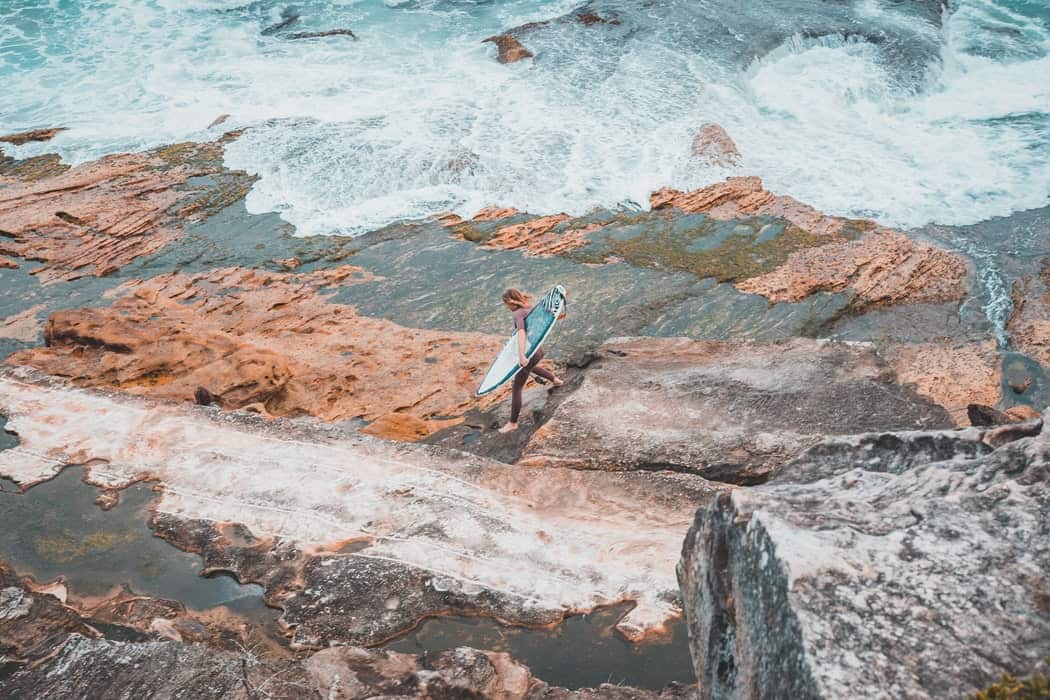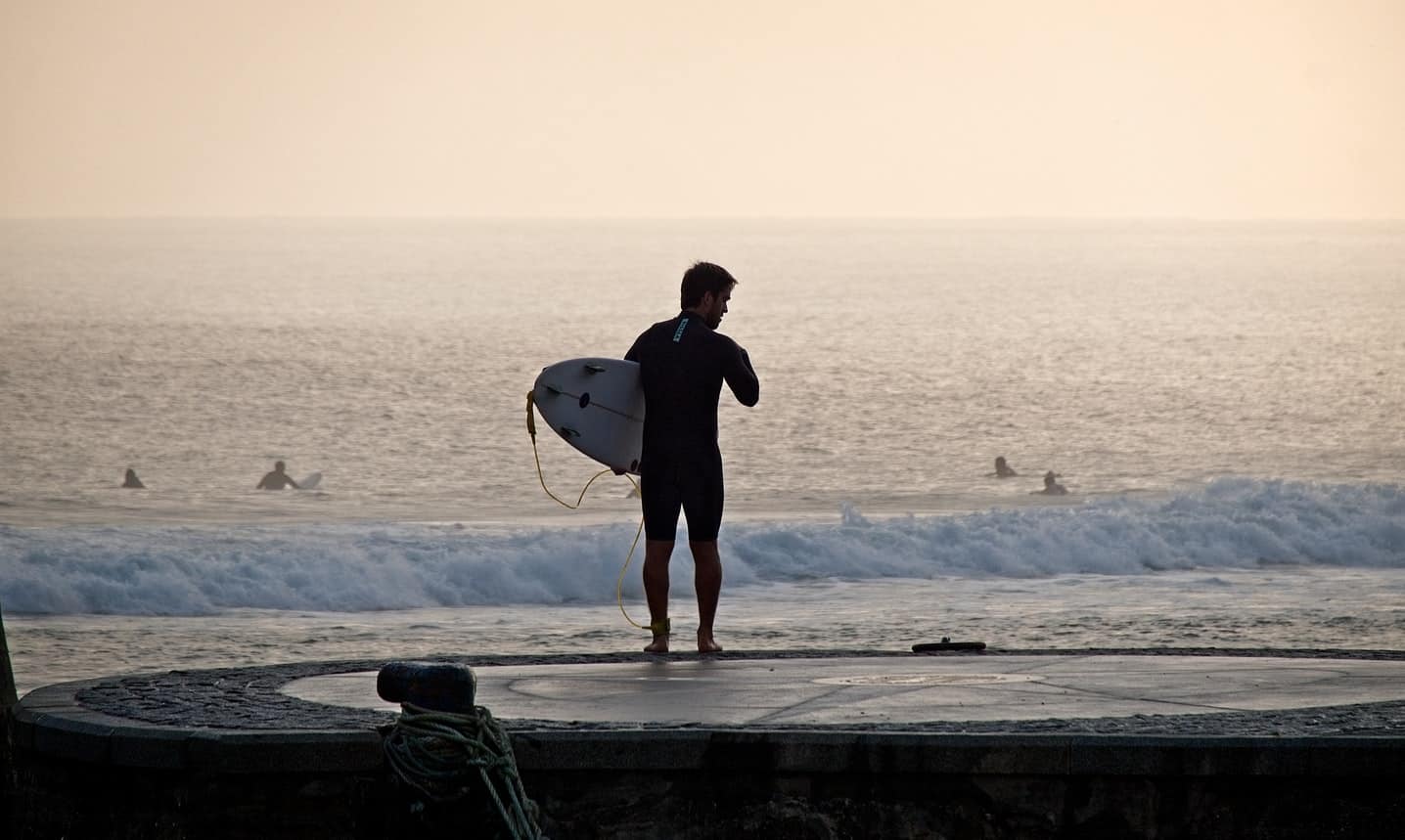One of the hardest things to know when out in the ocean is when you find yourself in a rip current and begin floating further out to sea. Rip currents often go unnoticed and can carry swimmers and surfers far out to unsafe distances. About 100 deaths per year are attributed to rip currents. Life preservers, vests and jackets keep out heads above the surface of the water until we can be rescued or until they pass when we can safely swim to shore on our own.
Can you surf with a life jacket on? While it’s not common for surfers to wear life jackets on average sized waves, most big wave surfers today wear them. Life jackets have saved the lives of many surfers and, if you surf in low tide and go far out from land, it’s a great idea to wear a life jacket. Tides change quickly and can catch you unawares.
Life jackets restrict the normal motion of your hands, which you use a lot for paddling around in the surf. Surfers who do a lot of big wave surfing have learned to surf wearing inflatable life jackets, knowing the dangers of waves crashing down to the ocean floor.
Life jackets and life vests are also known as personal flotation devices or PFDs.
What Is Big Wave Surfing?
Big wave surfing is a discipline distinct from whitewater or regular surfing that’s a hobby practiced by experienced and professional surfers. Waves 20 feet high or more are known as “big waves.” Some waves over 30 feet require the surfer to be towed towards its peak since it’s difficult or impossible to reach the top of a wave by just paddling.
Surfers ride gun boards when they ride big waves. These larger and longer boards help a surfer paddle fast enough to catch big waves and the boards are more stable due to their size.
Some big wave surfers are towed in by jet skis, and since the advent of tow in surfing, many surfers have traded their ungainly 12-foot surfboards for shorter and easier to ride 7 foot shortboards, allowing them to maneuver more easily on waves higher than 30 feet. Tow in surfing allows surfers to face waves bigger than 50 feet in height.
What Are The Dangers Of Big wave Surfing?
Big wave surfing has become a specialty to many professional surfers. 2 famous big wave surfers, Mark Foo and Malik Joyeux both died while preparing for upcoming big wave competitions; Foo in 1994 in Mavericks in Northern California (pro surfer Sion Milosky would also die at Mavericks in 2011), and Joyeux on Oahu, Hawaii in 2005. Several other surfers also lost their lives either practicing or in the middle of a big wave competition.
Wipeouts are the biggest hazard associated with big wave surfing. When a surfer wipes out, the breaking wave can push him down with great force as far as 50 feet below the surface. Once the spinning action the waves cause to the body, the surfer has to regain his equilibrium and determine the right direction back to the surface. This is not always easy to do, and some surfers can drown, not knowing which way is up.
Once the wave pushes them down underneath the ocean’s waters, a surfer has about 20 seconds to regain the surface before another wave hits them. The second wave comes with such force that it can knock them unconscious.
The pressure of the water 50 feet below the surface is so strong that it has been known to rupture the eardrums of surfers. Also, if there are reefs nearby, the force of the wave can push a surfer directly into it, causing serious bodily injury.
There is a surfing term known as the “triple hold down.” This happens when surfers are held underwater by two or more consecutive waves. Self-control and keeping one’s cool are key to surviving extended periods underwater when you can’t regain the surface. We can hold our breaths longer than we think, and if a surfer doesn’t panic, there are excellent chances he’ll make it to the surface in time.
What Are The Advantages Of Wearing A Life Jacket?
Life vests and life jackets have taken an increasingly important role in big wave surfing. They gained even more popularity when inflatable models were designed and marketed to surfers.
Only 10 years ago, you were unlikely to see anyone at all wearing inflatable vests at big wave surf competitions. In 2019, all competitors except for 4, wore these life-saving devices.
When a big wave surfer is tackled by a wave that then sends him plummeting down 30 to 40 feet, he can pull one of the several strings attached to the life jacket. It will inflate and bring him right to the surface in a matter of a few seconds.
If a surfer is caught in a rip current, he can keep his head above water and either swim out of the current back to shore or wait for help; he can even swim parallel to the shoreline until he is out of the rip current and can then swim safely back to land.

What Is A Life Jacket Made Of?
Inflatable life vests and life jackets are referred to as personal flotation devices. PFDs used for big wave surfing are usually made of neoprene, which is a soft, pliable rubber material that comes in different thicknesses.
Inside the life jacket is found a heat-sealed urethane bladder. The bladder is connected to canisters containing carbon dioxide. There are usually 4 of these canisters, and they are stored inside a pouch found on the back of the life vest or jacket.
There are pull tabs on the outside of the PFD, and each tab is connected to a dedicated canister. When the tab is pulled, a nail punctures the carbon dioxide cartridge; the gas is released and expands, filling the bladder.
The bladder, filled with the gas, allows the body to float and remain buoyant and to float upwards after it becomes submerged in the water.
Most life jackets come with a tab to deflate the bladder once the surfer wearing it is safe again. He can also dive down into the water when the PFD is deflated.
What Kind Of Inflatable Life Jacket Is Right For Me?
There are two basic types of life jackets or vests. The first is a self-inflating vest, which is a kind of auto inflatable life jacket. The second is a manually inflatable life jacket. Both include a backup for oral inflation should the initial attempt to inflate fails.
Auto inflating life jackets are becoming more and more popular on the big wave surfing circuit. These inflate when submerged in water, or when the chord is manually pulled.
The auto inflate model inflates with such force as to take the surfer right up to the surface. Auto inflate models are perfect for dangerous situations on the water, such as big wave surfing. In the event of loss of consciousness, the surfer will automatically rise to the surface.
It is admittedly a difficulty wearing a life jacket in normal surfing conditions; on the other hand, it is almost required for big wave surfers to wear.
Related Questions
Has Climate Change Made Waves Bigger And Surfing More Dangerous?
In the past 5 years, we hear more and more reports from scientists and researchers who follow climate change. They have made some interesting discoveries.
As recently as last year, a study published in the scientific research magazine Nature, found that as the surface temperature of the ocean increases, waves created in the ocean are getting stronger and stronger.
This brings new, even deadly challenges, to big wave surfers, making the use of life vests mandatory for the kind of surfing they do.
It might be that in a few decades, all waves will rise significantly in height, making life jackets a compulsory PFD to wear.
How Much Does A Life Jacket Cost?
Good quality life jackets should not cost more than $100.00. You can expect to spend anywhere from $50.00 to $75.00 to suit your needs.
Life jackets should be models approved by the National Guard Sea Rescue division. The best life jacket brands are those that have been tested and are virtually failproof. Brands to look for are O’Neil, Eyson, ONYX, and Stohlquist.
Where Are The Best Places To Ride Big Waves?
Big wave “hot zones” are located in Hawaii, Australia, Indonesia, and California. Ireland has a handful of places where waves are prominent.
An area infamous for extremely dangerous big waves is in Maui, an area known as “Jaws.” Surfers expect to spend most of the time doing water somersaults, because Jaws is notorious for multiple waves crashing in tandem. A surfer falls into the ocean, comes up and crashes down again and again.
Oaxaca, California is where Puerto Escondido is located. Here the waves rise to 40 feet in height. Instead of tube surfing, this part of the California coast is known for waves that appear like walls crashing into beach break.
Tahiti, Fiji, and Tasmania are places where serious surfers travel to, with each local offering a different challenge.

